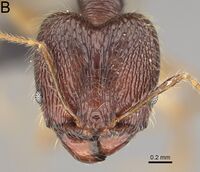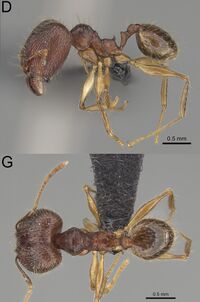Pheidole mahamavo
| Pheidole mahamavo | |
|---|---|

| |
| Scientific classification | |
| Kingdom: | Animalia |
| Phylum: | Arthropoda |
| Class: | Insecta |
| Order: | Hymenoptera |
| Family: | Formicidae |
| Subfamily: | Myrmicinae |
| Tribe: | Attini |
| Genus: | Pheidole |
| Species group: | sikorae |
| Species: | P. mahamavo |
| Binomial name | |
| Pheidole mahamavo Salata & Fisher, 2020 | |
The species was collected at 900 m in elevation, in montane rainforest. The nest was located in leaf litter.
Identification
Salata and Fisher (2020) - A member of the Pheidole sikorae species group. Moderately large species. Major: Head in full-face view sub-oval, not widening posteriorly, with anterior and posterior sides slightly convex, in lateral view sub-oval; ventral and dorsal faces convex; sides of the head with very dense, long, suberect to erect pilosity; medial part of frons with thick, interrupted, dense, and longitudinal rugae with smooth interspaces; lateral sides of frons with thick and denser rugae with smooth to indistinctly rugulate interspaces, anterolateral sides with longitudinal rugae; posterolateral sides with rugae more irregular; occipital lobes and area posterolateral from eyes without smooth notches; scape, when laid back, exceeding the midlength of head by two-fifths of its length; inner hypostomal teeth distinct, large, and wide, closely spaced, triangular with apex directed upward; outer hypostomal teeth lobe-like, narrower, and approximately as high as inner teeth, apex directed upward; inner and outer hypostomal teeth closely spaced and not connected by concavity; mesosoma rugofoveolate; pronotum with reduced rugofoveolae and with additional sparse and thin transverse rugae; katepisternum with smooth notch; gaster smooth; body brown. Minor: Head foveolate; vertex with fading foveolae and additional transverse rugae; frons with distinct and sparse, longitudinal rugae; area posterolateral from eyes smooth; scape, when laid back, exceeding the posterior head margin by one-third of its length; promesonotum low and moderately long; promesonotal groove present; propodeal spines minute, triangular; mesosoma foveolate; promesonotal dorsum and katepisternum with smooth notches; body brown.
Pheidole mahamavo is most similar to sympatric Pheidole veteratrix, and to Pheidole trichotos, and Pheidole anomala, known from a remote locality in Antsiranana prefecture. Major workers of P. mahamavo can be easily separated from those three taxa based on presence of thick, interrupted, dense, and longitudinal rugae with smooth interspaces on medial frons and more longitudinal rugae on lateral sides of frons; minors can be separated from P. veteratrix and P. trichotos based on presence of distinct and arcing rugae on vertex and sparser sculpture on pronotal dorsum, and from P. anomala based on darker brown body colouration, sparser sculpture on propodeum, and presence of distinct and arcing rugae on vertex.
Distribution
Distribution based on Regional Taxon Lists
Malagasy Region: Madagascar (type locality).
Distribution based on AntMaps
Distribution based on AntWeb specimens
Check data from AntWeb
Countries Occupied
| Number of countries occupied by this species based on AntWiki Regional Taxon Lists. In general, fewer countries occupied indicates a narrower range, while more countries indicates a more widespread species. |

|
Biology
Castes
Worker
minor
Nomenclature
The following information is derived from Barry Bolton's Online Catalogue of the Ants of the World.
- mahamavo. Pheidole mahamavo Salata & Fisher, 2020: 94, figs. 39A–F, 63U, 66A (w.) MADAGASCAR.
Unless otherwise noted the text for the remainder of this section is reported from the publication that includes the original description.
Description
Worker
Major (N = 2): HL: 1.38, 1.36; HW: 1.33, 1.35; SL: 0.91, 0.91; EL: 0.17, 0.19; WL: 1.2, 1.18; PSL: 0.19, 0.2; MTL: 0.9, 0.91; PNW: 0.51, 0.52; PTW: 0.15, 0.17; PPW: 0.33, 0.35; CI: 104.2, 100.4; SI: 68.3, 67.5; PSLI: 13.9, 14.5; PPI: 44.2, 48.3; PNI: 38.6, 38.3; MTI: 67.8, 67.1.
Head. In full-face view sub-oval, not widening posteriorly, with anterior and posterior sides convex. In lateral view sub-oval; ventral and dorsal faces convex; inner hypostomal teeth visible. Sides of the head with very dense, long, suberect to erect pilosity; whole head with dense, long, decumbent to erect pilosity. Medial part of frons with thick, interrupted, dense, and longitudinal rugae with smooth interspaces; lateral sides of frons with thick and denser rugae with smooth to indistinctly rugulate interspaces, anterolateral sides with longitudinal rugae; posterolateral sides with more irregular rugae. Occipital lobes with sparser and fading irregular rugae and indistinctly rugulate to smooth interspaces. Area posterolateral from eyes with dense, moderately thick, longitudinal rugae with smooth to indistinctly rugulate interspaces, sculpture slightly fading posteriorly. Gena with relatively sparse, thick, longitudinal rugae and indistinctly rugulate interspaces. Centre of clypeus smooth with few longitudinal rugulae and shiny, lateral sides with indistinct rugulae; median notch present, moderately wide, and shallow; median longitudinal carina present; lateral longitudinal carinae absent. Scape, when laid back, exceeding the midlength of head by two-fifths of its length; pilosity subdecumbent to erect. Inner hypostomal teeth distinct, large, and wide, closely spaced, triangular with apex directed upward; outer hypostomal teeth lobe-like, narrower, and approximately as high as inner teeth, apex directed upward; inner and outer hypostomal teeth closely spaced and not connected by concavity. Mesosoma. In lateral view, promesonotum short, angular, and moderately low, posterior mesonotum moderately steep, mesonotal process indistinct, tubercle-like; promesonotal groove absent; metanotal groove absent; propodeal spines moderately long, narrow and with acute apex; humeral area weakly produced. Surface shiny and rugofoveolate; pronotum with reduced rugofoveolae and with additional sparse and thin transverse rugae; katepisternum with smooth notch. Pilosity moderately dense, long, and erect. Petiole. Shiny with foveolate; node finely smooth, triangular, with rounded and thick apex, in rear view node dorsoventrally slightly convex; pilosity moderately sparse and erect. Postpetiole. Shiny and foveolate; in dorsal view oval, lateral margins medially with two very small and dentate projections; pilosity long, moderately sparse, and erect. Gaster. Shiny and smooth; pilosity moderately dense, long, and erect. Colour. Brown, antenna and legs yellowish.
The following characters are found in most Pheidole sikorae species-group majors in Madagascar (Salata and Fisher 2020b). These characters also occur in Pheidole mahamavo, except for any differences noted in the paragraph above. Dorsal face of head in lateral view not depressed posteriorly; antennal sockets shallow; frontal lobes absent; head in full-face view with distinct median concavity; antenna 12-segmented, with 3-segmented club; masticatory margin of mandible with large, stout apical and preapical teeth, followed by a long diastema and then a short and crenulate tooth just before the rounded basal angle; outer surface of mandible mostly smooth and shining, sometimes with weak and sparse foveolae; antennal scrobes absent; promesonotum strongly convex, well above the level of propodeum; petiolar peduncle with small horizontal lobes on its basal part; postpetiole short with slightly convex dorsum; petiolar peduncle without horizontal lobes on its basal part; body unicolourous.
Minor (N = 5): HL: 0.64-0.69 (0.67); HW: 0.51-0.54 (0.53); SL: 0.8-0.87 (0.84); EL: 0.13-0.14 (0.13); WL: 0.89-0.93 (0.91); PSL: 0.09-0.11 (0.1); MTL: 0.64-0.73 (0.7); PNW: 0.34-0.37 (0.36); PTW: 0.09-0.1 (0.09); PPW: 0.15-0.16 (0.15); CI: 123.3-127.3 (124.9); SI: 154.3-161.4 (157.1); PSLI: 13.2-16.7 (14.5); PPI: 57.8-66.9 (61.4); PNI: 64.8-68.6 (66.7); MTI: 126.0-136.5 (130.6).
Head. Cephalic margin slightly convex. Pilosity relatively sparse, short, subdecumbent. Sculpture shiny and foveolate; vertex with fading foveolae and additional transverse rugae; frons with distinct and sparse, longitudinal rugae; area posterolateral from eyes smooth; antennal sockets with few indistinct, curved outward rugae and foveolate interspaces. Clypeus with median longitudinal carina absent; two lateral longitudinal carinae absent. Scape, when laid back, exceeding the posterior head margin by one-third of its length; pilosity dense, subdecumbent to erect. Mesosoma. In lateral view, promesonotum low and moderately long, arched; promesonotal groove indistinct; metanotal groove distinct; propodeal spines minute and triangular. Sculpture shiny and foveolate; promesonotal dorsum and katepisternum with smooth notches. Pilosity sparse, moderately long, and erect. Gaster. With sparse, erect pilosity. Colour. Brown, legs, gaster and antenna yellowish.
The following characters are found in most Pheidole sikorae species-group minors in Madagascar (Salata and Fisher 2020b). These characters also occur in Pheidole mahamavo, except for any differences noted in the paragraph above. Antennal sockets shallow; frontal lobes absent; occipital carina absent; head in full-face view oval, posterior and anterior of eyes convex; antenna 12-segmented, with 3-segmented club; humeral area not developed; clypeus smooth and shiny, its anterior margin regularly convex; promesonotum well above the level of propodeum; petiole smooth, with node moderately low, triangular, and small, with few short, erect setae; petiolar peduncle with ventral face slightly convex; postpetiole smooth, short, low, and slightly convex, with few short, erect setae; gaster smooth and shiny; body unicolourous.
Type Material
Holotype. Madagascar. 1 major worker; Toliara; Parc National d'Andohahela, Col du Sedro, 3.8 km 113°ESE Mahamavo, 37.6 km 341°NNW Tolagnaro; -24.76389, 46.75167; alt. 900 m; 21 Jan 2002; Fisher et al. leg.; montane rainforest, canopy moss and leaf litter; BLF05135; CASENT0923292, bottom specimen on the pin (California Academy of Sciences). Paratypes. 6w., 1s.; same data as for holotype, CASENT0455920, CASENT0455921, CASENT0455922 (CASC, Musee d'Histoire Naturelle Genève, Parc Botanique et Zoologique de Tsimbazaza).
Etymology
From the type locality.


